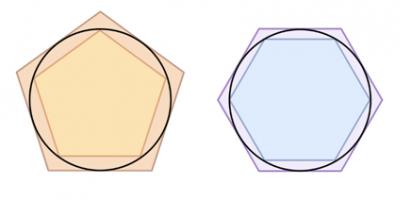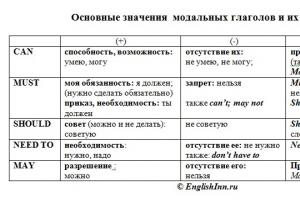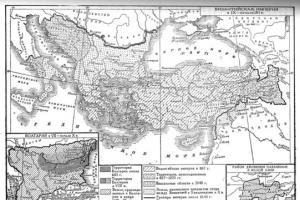Perimeter of a triangle, as with any figure, is called the sum of the lengths of all sides. Quite often this value helps to find the area or is used to calculate other parameters of the figure.
The formula for the perimeter of a triangle looks like this:
![]()
An example of calculating the perimeter of a triangle. Let a triangle be given with sides a = 4 cm, b = 6 cm, c = 7 cm. Substitute the data into the formula: cm
Formula for calculating perimeter isosceles triangle will look like this:
![]()
Formula for calculating perimeter equilateral triangle:
An example of calculating the perimeter of an equilateral triangle. When all sides of a figure are equal, they can simply be multiplied by three. Suppose we are given a regular triangle with a side of 5 cm in this case: cm
In general, once all the sides are given, finding the perimeter is quite simple. In other situations, you need to find the size of the missing side. In a right triangle you can find the third side by Pythagorean theorem. For example, if the lengths of the legs are known, then you can find the hypotenuse using the formula: 
Let's consider an example of calculating the perimeter of an isosceles triangle, provided that we know the length of the legs in a right isosceles triangle.
Given a triangle with legs a =b =5 cm. Find the perimeter. First, let's find the missing side c. cm
Now let's calculate the perimeter: cm
The perimeter of a right isosceles triangle will be 17 cm.
In the case when the hypotenuse and the length of one leg are known, you can find the missing one using the formula: 
If the hypotenuse and one of the acute angles are known in a right triangle, then the missing side is found using the formula.
Any triangle is equal to the sum of the lengths of its three sides. General formula for finding the perimeter of triangles:
P = a + b + c
Where P is the perimeter of the triangle, a, b And c- his sides.
You can find it by adding the lengths of its sides sequentially or by multiplying the length of the side by 2 and adding the length of the base to the product. The general formula for finding the perimeter of isosceles triangles will look like this:
P = 2a + b
Where P is the perimeter of an isosceles triangle, a- any of the sides, b- base.

You can find it by adding the lengths of its sides sequentially or by multiplying the length of any of its sides by 3. The general formula for finding the perimeter of equilateral triangles will look like this:
P = 3a
Where P is the perimeter of an equilateral triangle, a- any of its sides.

Square
To measure the area of a triangle, you can compare it to a parallelogram. Consider a triangle ABC:

If you take a triangle equal to it and place it so that you get a parallelogram, you will get a parallelogram with the same height and base as the given triangle:

In this case, the common side of the triangles folded together is the diagonal of the formed parallelogram. From the properties of parallelograms it is known that the diagonal always divides the parallelogram into two equal triangles, which means the area of each triangle is equal to half the area of the parallelogram.
Since the area of a parallelogram is equal to the product of its base and its height, the area of the triangle will be equal to half of this product. So for Δ ABC the area will be equal
Now consider a right triangle:

Two equal right triangles can be folded into a rectangle by placing their hypotenuse against each other. Since the area of a rectangle is equal to the product of its adjacent sides, the area of a given triangle is:
From this we can conclude that the area of any right triangle is equal to the product of the legs divided by 2.
From these examples we can conclude that The area of any triangle is equal to the product of the length of the base and the height of the base, divided by 2. The general formula for finding the area of triangles will look like this:
| S = | ah a |
| 2 |
Where S is the area of the triangle, a- its foundation, h a- height lowered to the base a.
Preliminary information
The perimeter of any flat geometric figure on a plane is defined as the sum of the lengths of all its sides. The triangle is no exception to this. First, we present the concept of a triangle, as well as the types of triangles depending on the sides.
Definition 1
We will call a triangle a geometric figure that is made up of three points connected to each other by segments (Fig. 1).
Definition 2
Within the framework of Definition 1, we will call the points the vertices of the triangle.
Definition 3
Within the framework of Definition 1, the segments will be called sides of the triangle.
Obviously, any triangle will have 3 vertices, as well as three sides.
Depending on the relationship of the sides to each other, triangles are divided into scalene, isosceles and equilateral.
Definition 4
We will call a triangle scalene if none of its sides are equal to any other.
Definition 5
We will call a triangle isosceles if two of its sides are equal to each other, but not equal to the third side.
Definition 6
We will call a triangle equilateral if all its sides are equal to each other.
You can see all types of these triangles in Figure 2.
How to find the perimeter of a scalene triangle?
Let us be given a scalene triangle whose side lengths are equal to $α$, $β$ and $γ$.
Conclusion: To find the perimeter of a scalene triangle, you need to add all the lengths of its sides together.
Example 1
Find the perimeter of the scalene triangle equal to $34$ cm, $12$ cm and $11$ cm.
$P=34+12+11=57$ cm
Answer: $57$ cm.
Example 2
Find the perimeter of a right triangle whose legs are $6$ and $8$ cm.
First, let's find the length of the hypotenuses of this triangle using the Pythagorean theorem. Let us denote it by $α$, then
$α=10$ According to the rule for calculating the perimeter of a scalene triangle, we get
$P=10+8+6=24$ cm
Answer: $24$ see.
How to find the perimeter of an isosceles triangle?
Let us be given an isosceles triangle, the lengths of the sides will be equal to $α$, and the length of the base will be equal to $β$.
By determining the perimeter of a flat geometric figure, we obtain that
$P=α+α+β=2α+β$
Conclusion: To find the perimeter of an isosceles triangle, add twice the length of its sides to the length of its base.
Example 3
Find the perimeter of an isosceles triangle if its sides are $12$ cm and its base is $11$ cm.
From the example discussed above, we see that
$P=2\cdot 12+11=35$ cm
Answer: $35$ cm.
Example 4
Find the perimeter of an isosceles triangle if its height drawn to the base is $8$ cm, and the base is $12$ cm.
Let's look at the drawing according to the problem conditions:
Since the triangle is isosceles, $BD$ is also the median, therefore $AD=6$ cm.
Using the Pythagorean theorem, from the triangle $ADB$, we find the lateral side. Let us denote it by $α$, then
According to the rule for calculating the perimeter of an isosceles triangle, we get
$P=2\cdot 10+12=32$ cm
Answer: $32$ see.
How to find the perimeter of an equilateral triangle?
Let us be given an equilateral triangle whose lengths of all sides are equal to $α$.
By determining the perimeter of a flat geometric figure, we obtain that
$P=α+α+α=3α$
Conclusion: To find the perimeter of an equilateral triangle, multiply the length of the side of the triangle by $3$.
Example 5
Find the perimeter of an equilateral triangle if its side is $12$ cm.
From the example discussed above, we see that
$P=3\cdot 12=36$ cm
The perimeter is the sum of all sides of a figure. This characteristic, along with area, is equally in demand for all figures. The formula for the perimeter of an isosceles triangle logically follows from its properties, but the formula is not as complicated as acquiring and consolidating practical skills.
Formula for calculating perimeter
The lateral sides of an isosceles triangle are equal to each other. This stems from the definition and is clearly visible even from the name of the figure. It is from this property that the perimeter formula stems:
P=2a+b, where b is the base of the triangle, a is the value of the side.

Rice. 1. Isosceles triangle
From the formula it is clear that to find the perimeter it is enough to know the size of the base and one of the sides. Consider several problems to find the perimeter of an isosceles triangle. We will solve problems as their complexity increases, this will allow us to better understand the way of thinking that needs to be followed to find the perimeter.
Problem 1
- In an isosceles triangle, the base is 6, and the altitude drawn to this base is 4. It is necessary to find the perimeter of the figure.

Rice. 2. Drawing for task 1
The altitude of an isosceles triangle drawn to the base is also the median and altitude. This property is very often used in solving problems involving isosceles triangles.
Triangle ABC with height BM is divided into two right triangles: ABM and BCM. In triangle ABM, leg BM is known, leg AM is equal to half the base of triangle ABC, since BM is the median bisector and altitude. Using the Pythagorean theorem, we find the value of the hypotenuse AB.
$$АВ^2=AM^2+BM^2$$
$$AB=\sqrt(AM^2+BM^2)=\sqrt(3^2+4^2)=\sqrt(9+16)=\sqrt(25)=5$$
Let's find the perimeter: P=AC+AB*2=6+5*2=16
Problem 2
- In an isosceles triangle, the altitude drawn to the base is 10, and the acute angle at the base is 30 degrees. you need to find the perimeter of the triangle.

Rice. 3. Drawing for task 2
This task is complicated by the lack of information about the sides of the triangle, but knowing the value of the height and angle, in the right triangle ABH you can find the leg AH, and then the solution will follow the same scenario as in problem 1.
Let's find AH through the value of the sine:
$$sin (ABH)=(BH\over AB)=(1\over2)$$ - the sine of 30 degrees is a table value.
Let's express the required side:
$$AB=((BH\over (1\over 2))) =BH*2=10*2=20$$
Using the cotangent we find the value of AH:
$$ctg(BAH)=(AH\over BH)=(1\over\sqrt(3))$$
$$AH=(BH\over\sqrt(3))=10*\sqrt(3)=17.32$$ - round the resulting value to the nearest hundredth.
Let's find the basis:
AC=AH*2=17.32*2=34.64
Now that all the required values have been found, let's determine the perimeter:
P=AC+2*AB=34.64+2*20=74.64
Problem 3
- The isosceles triangle ABC has an area of $$16\over\sqrt(3)$$ and an acute angle at the base of 30 degrees. Find the perimeter of the triangle.
The values in the condition are often given as the product of the root and the number. This is done to protect the subsequent solution as much as possible from errors. It is better to round the result at the end of calculations
With this formulation of the problem, it may seem that there are no solutions, because it is difficult to express one of the sides or the height from the available data. Let's try to solve it differently.
Let us denote the height and half of the base in Latin letters: BH=h and AH=a
Then the base will be equal to: AC=AH+HC=AH*2=2a
Area: $$S=(1\over 2)*AC*BH=(1\over 2)*2a*h=ah$$
On the other hand, the value of h can be expressed from the triangle ABH in terms of the tangent of the acute angle. Why tangent? Because in triangle ABH we have already designated two legs a and h. One must be expressed through the other. Two legs together connect tangent and cotangent. Traditionally, cotangent and cosine are used only if tangent or sine does not fit. This is not a rule, you can decide as it is convenient, it’s just accepted.
$$tg(BAH)=(h\over(a))=(1\over\sqrt(3))$$
$$h=(a\over\sqrt(3))$$
Let's substitute the resulting value into the area formula.
$$S=a*h=a*(a\over\sqrt(3))=((a^2)\over\sqrt(3))$$
Let's express a:
$$a=\sqrt(S*\sqrt(3))=\sqrt(16\over\sqrt(3)*\sqrt(3))=\sqrt(16)=4$$
Substitute the value of a into the area formula and determine the value of the height:
$$S=a*h=(16\over\sqrt(3))$$
$$h=(S\over(a))=((16\over\sqrt(3))\over(4))=(4\over\sqrt(3))=2.31$$- obtained value Let's round to the nearest hundredth.
Using the Pythagorean theorem we find the lateral side of the triangle:
$$AB^2=AH^2+BH^2$$
$$AB=\sqrt(AH^2+BH^2)=\sqrt(4^2+2.31^2)=4.62$$
Let's substitute the values into the perimeter formula:
P=AB*2+AH*2=4.62*2+4*2=17.24
What have we learned?
We have understood in detail all the intricacies of finding the perimeter of an isosceles triangle. We solved three problems of different levels of complexity, showing with an example how typical problems for solving an isosceles triangle are solved.
Test on the topic
Article rating
Average rating: 4.4. Total ratings received: 83.








